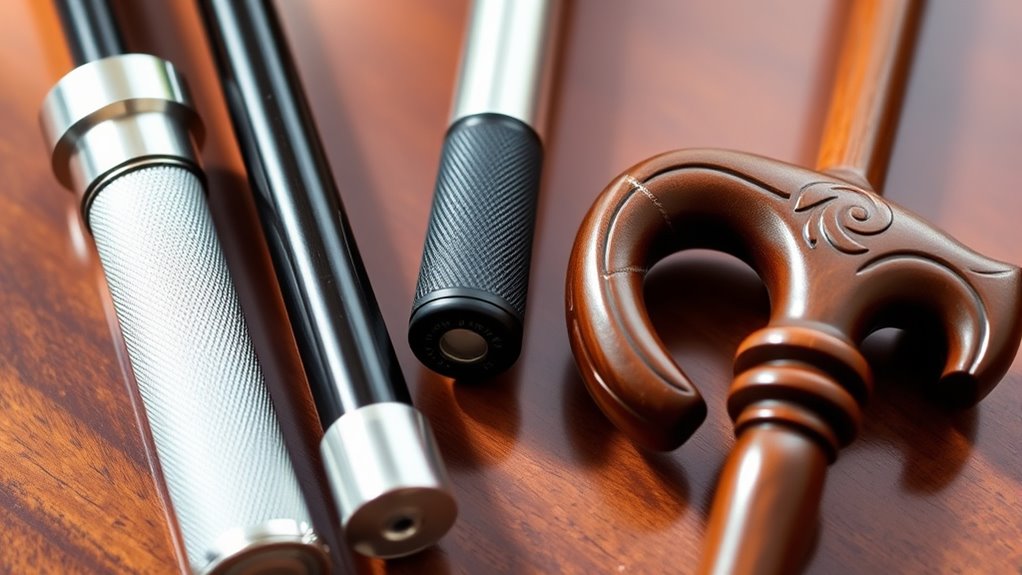To choose the right cane, focus on an ergonomic handle that fits comfortably in your hand and reduces strain, especially if you have arthritis. Adjust the height so it aligns with your wrist when standing, ensuring proper posture and balance. Consider a stable base, like a rubber tip or quad support, for safety on various surfaces. Lightweight materials make handling easier. Keep in mind additional features like sound therapy for extra comfort—learn more about finding your perfect match below.
Key Takeaways
- Ensure the cane height aligns with wrist level when standing upright for proper support.
- Select a handle type that fits comfortably and offers a secure grip, such as ergonomic designs.
- Consider base options like rubber tips or quad bases for increased stability on different terrains.
- Choose lightweight materials like aluminum for easy maneuverability and portability.
- Assess additional features like sound therapy or adjustable height to enhance comfort and support.

Choosing the right cane is vital for guaranteeing proper support and safety. When selecting a cane, one of the most significant features to weigh is the ergonomic handle. An ergonomic handle is designed to fit comfortably in your hand, reducing strain and preventing discomfort during extended use. It allows you to grip the cane securely without exerting unnecessary pressure on your palm or fingers. This feature is especially advantageous if you have arthritis or limited hand strength. The right handle not only improves comfort but also enhances stability, helping you to maintain better control as you walk. Additionally, incorporating sound therapy principles into your routine can promote relaxation and reduce muscle tension, further supporting your mobility. In addition to the handle, adjustable height is a key factor. A cane with adjustable height lets you customize the length so it aligns perfectly with your body. When you stand upright with your arms relaxed at your sides, the top of the cane should reach about the level of your wrist. This positioning guarantees that you’re not leaning or hunching, which can cause fatigue or imbalance. An adjustable cane makes it easier to find that perfect height, especially if multiple people in your household will use it or if your mobility needs change over time. It also offers flexibility for different terrains or walking conditions, allowing you to modify the length slightly to adapt to uneven surfaces or stairs. When choosing a cane, you’ll want to think about the material and weight as well. Lightweight aluminum canes are popular because they’re sturdy yet easy to carry and maneuver. However, guarantee the adjustable mechanism is sturdy and easy to operate, so it doesn’t slip or loosen unexpectedly. Look for a cane with a secure locking system for the height adjustment, giving you peace of mind that it will stay in the desired position. The base of the cane is also important. A rubber tip at the bottom provides grip and prevents slipping on smooth surfaces like tile or hardwood. Some canes come with a quad base—wider and more stable—ideal if you need extra support. Ultimately, trying out different canes in person can help you determine what feels most comfortable and secure. When you focus on ergonomic handles and adjustable height, you’re making choices that support your mobility and safety. Guarantee the cane fits well in your hand, matches your height, and offers stability for your daily routines. By paying attention to these features, you’ll find a cane that not only supports your body but also boosts your confidence as you move around.
Frequently Asked Questions
How Do I Measure the Correct Cane Height?
To measure the correct cane height, stand upright with your arms relaxed at your sides, then bend your elbow to about a 15-20 degree angle. Hold the cane with an ergonomic grip at this height, ensuring it feels comfortable and stable. If your cane is adjustable, set its length to match this measurement. Proper fit prevents strain and enhances support, making walking safer and more comfortable.
Are There Specific Canes for Different Terrains?
Yes, there are terrain-specific canes designed for different environments. For outdoor use, you’ll want a cane made from durable outdoor cane materials like aluminum or rubber. These can handle uneven surfaces, gravel, or wet conditions better than indoor canes. Terrain-specific canes often have features like heavier bases or textured grips to prevent slipping and provide stability, helping you stay confident and safe while exploring various outdoor terrains.
Can I Customize the Handle for Better Comfort?
Like Da Vinci refining his masterpiece, you can customize your cane’s handle for comfort. You’ll find ergonomic grip options that fit your hand perfectly, reducing strain and increasing stability. Handle adjustment features allow you to tailor the cane to your height and preference, making each step feel natural and secure. Investing in a customized handle guarantees your cane supports you confidently, blending functionality with personalized comfort.
What Materials Are Most Durable for Outdoor Use?
For outdoor use, you want durable materials like aluminum or carbon fiber, which are lightweight and withstand weather conditions well. When selecting a cane, consider cane grip options that provide a secure hold, even in wet conditions. These lightweight cane materials guarantee you stay mobile without added fatigue, and the sturdy grip options improve safety. Choosing the right combination helps you enjoy outdoor activities confidently and comfortably.
How Often Should I Replace My Cane?
You should replace your cane as often as you’d change your phone—probably every year or two, especially if you notice cracks, wobbling, or discomfort. Keep it in top shape with handy cane accessories and proper cane storage tips to prevent damage. Regularly check for signs of wear, and if it’s no longer reliable or comfortable, don’t hesitate to replace it. Your safety depends on it!
Conclusion
Now, as you stand tall with your perfect cane, imagine it as an extension of yourself—steadying your steps, guiding you confidently through each day. Picture the gentle weight in your hand, the sturdy grip supporting your journey. With the right fit and style, your cane becomes more than just help; it’s a trusted companion on your path forward. Embrace it, and walk with assurance into every new adventure that awaits.









